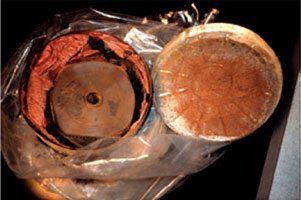Nitrate Degradation
 |
|
The rusting is caused by acid gases emitted by the degrading nitrate film.
|
The most serious problems originate from deterioration of plastic film support. Most preservationists are familiar with nitrate film decomposition. Cellulose nitrate film stock was in commercial use through the early 1950s, when it was replaced by cellulose acetate plastic "safety film."
Nitrate degradation is a slow chemical process that occurs because of two factors: the nature of cellulose nitrate plastic itself and the way that the film is stored. As nitrate film decays, it can become highly flammable at relatively low temperatures.
In spite of nitrate's inherent tendency to self-destruct, the natural aging process can be greatly slowed down by low-temperature storage. The original nitrate negative of Edison's 1903 classic, The Great Train Robbery, is in excellent condition, residing happily in cold storage in the Library of Congress film vault. The lesson from nitrate that applies to all the major deterioration problems is that "nurture" (a good environment) can win over "nature" (the inherent rapid degradation of plastics and dyes under poor storage conditions). But good storage conditions have to be put in place BEFORE the film becomes too far gone.
